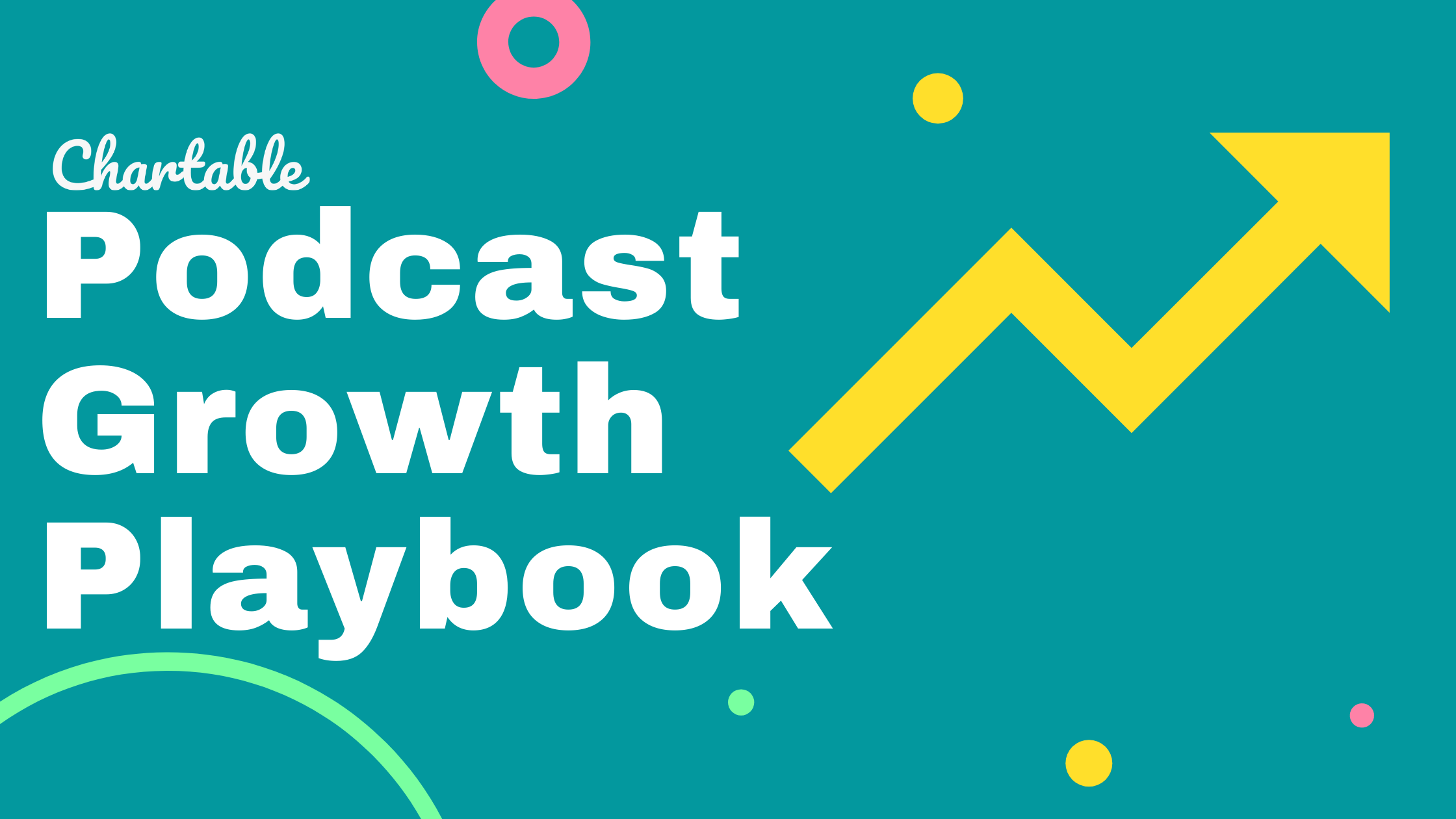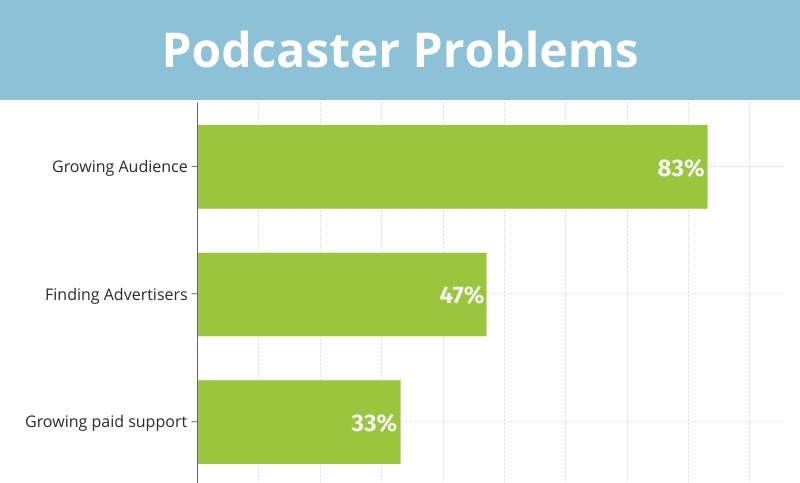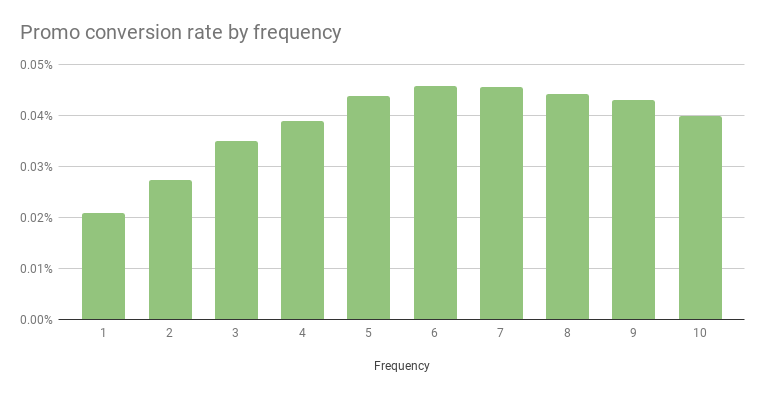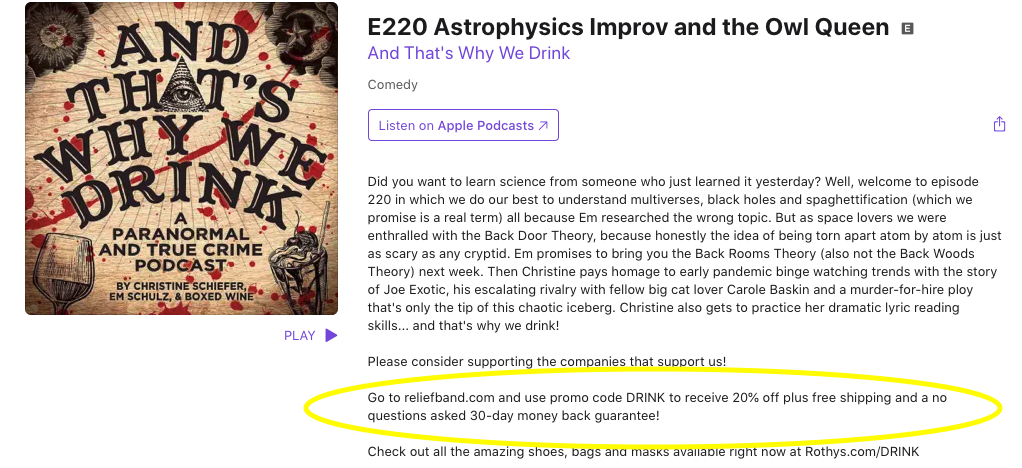Every month, nearly 120 million Americans tune into a podcast.
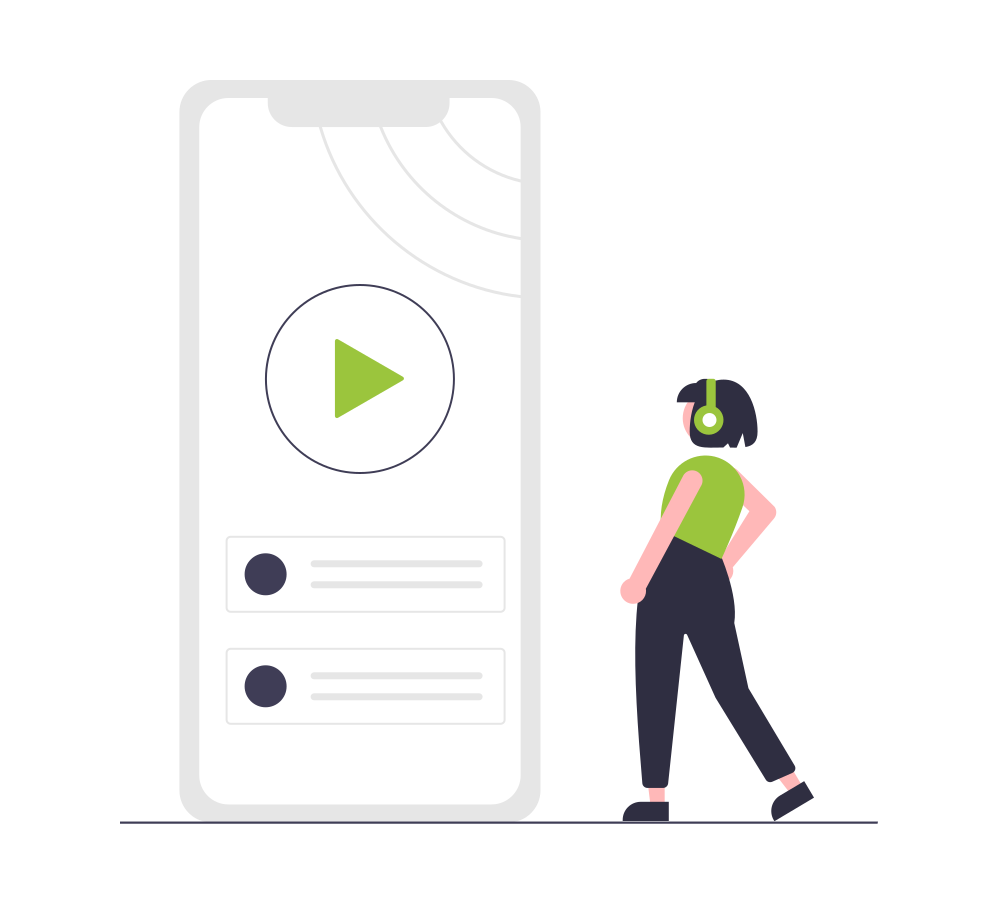
And every thirty seconds, somebody starts a new one — there are now over 2 million podcasts.
This growing interest from listeners and creators has created a lot of excitement in the podcast industry. But the additional competition also makes it harder than ever to stand out from the crowd.
At Chartable, we’ve created the tools for publishers to measure their podcast marketing and answer two basic questions:
What’s growing my podcast, and where should I invest my marketing budget?
We'll review the challenges behind measuring podcast tune-in and digital campaigns, and how both can now be measured using two tools provided by Chartable: SmartPromos and SmartLinks.
Whether you're just starting a podcast, an established publisher, or have a podcast for your brand, it's easier than ever to grow your show with scalable, repeatable data-driven techniques.
A recent survey of hundreds of Chartable users found that growing your audience was the #1 problem for podcasters — 83% of podcasters listed it as a problem.
Perhaps it shouldn't be surprising that podcasters want more downloads—if we could wave a magic wand to grow your audience, we would! Unfortunately, getting more listeners isn't easy, but it also doesn't require any magic.
We've developed a four-step method based on best practices we've developed working alongside the top publishers in the world:
- Set goals and budget
- Make a media plan
- Measure results
- Optimize and repeat
Before we dive in, it's worth noting that before you invest time growing your podcast, you should consider whether you're truly ready to market your show. Have you thought about who your ideal audience is? Have you gotten feedback from your listeners on what's working (or not working) with your content? Are you committed to continually producing a show that delivers value to your audience and is ultimately worth the time they'll invest in listening?
If so, read on— here's how to grow your show.
We'll focus on marketing with podcast-to-podcast audio campaigns and digital ads; there are other resources that focus on other tactics, like this guide from Anchor which includes ideas like guesting, and this post from Lower Street which has great tactics like transcriptions and uploading to YouTube.
Before digging into specific tactics, it's important to think about your goals. What do you want to achieve? How will you know that you've achieved it?
We suggest focusing on downloads as your key performance indicator (KPI), because downloads are still the gold-standard metric in podcasting. For example, you can set yourself a simple goal such as, "I want to get 500 more downloads over the next 30 days."
Once you have that goal, it's important to look at your budget and estimate how much you'll need to spend to achieve your goal. We suggest focusing on cost per download (CPD) for allocating your marketing dollars effectively — that is, how much does it cost you to acquire a single additional download?
Calculating cost per download (CPD) is pretty straightforward:
For example, if you spent $20 on a mid-roll that got you 16 new downloads, your CPD would be ($20 / 16) = $1.25 per new download.
Now that you have your goal and budget in hand, it's time to plan your marketing campaign.
The start of any great podcast tune-in campaign is a media plan — a schedule of where and when you'll advertise your show. Let's review the basics of a podcast media plan.
There are four major podcast ad placements, each of which can be made up of either host-read or producer read spots and can be baked-in or dynamically inserted into the episode. We go into more detail on these podcast advertising basics in our Effective Podcast Advertising whitepaper, but here's a quick refresher:
- Pre-Roll: placed before a show
- Mid-Roll: placed in the middle of a show
- Post-Roll: placed at the end of a show
- Episode Drop: stand-alone episode dropped into the promoting show's RSS feed.
Each of these placements is priced differently. We often get asked: how much should I pay for a promotional ad? The answer is, of course, "it depends"— but here are some benchmarks:
- Pre-Roll: typical CPM = $18, ranges from $10-20
- Mid-Roll: typical CPM = $25, ranges from $15-30
- Post-Roll: typical CPM = $10, ranges from $0-25
- Episode Drop: $30-50 CPM. Expect to pay more if the theme of the promoting show is close to the show that's being promoted.
The cost per download will vary between genres and ad placement.
Think about your target audience when making your media plan. For example, if your ideal listener is aged 18-25, ask for demographics on the other network's audience to see if it's a fit. (Small plug: Chartable has a tool for publishers to see demographics on their listeners—ask folks you're working with to share their demos!)
Genre alignment matters. For example, if you’re promoting an Audio Drama, you should buys ads on Audio Dramas. This ensures you're reaching the right audience—your future listeners—with your ad buy, and can help deepen audience alignment between listeners of your podcast and those who like similar shows.
Ad placements matter too. While it's the most expensive ad format, episode drops tend to convert the best, followed by mid-rolls, pre-rolls, and post-rolls.
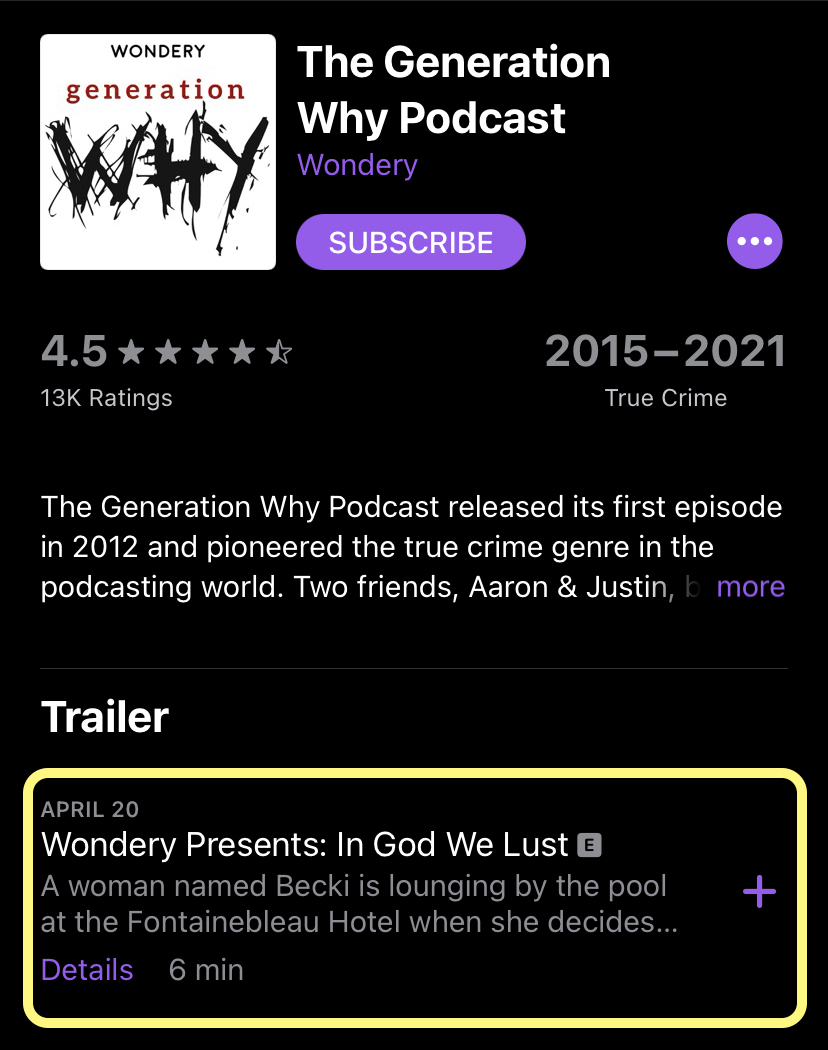
We recommend buying as many episode drops as possible. If the episode drop is too expensive or not available, try to purchase a mid-roll + post-roll. The mid-roll can introduce your show and tee up the post-roll, which can be a trailer for your podcast.
Why are episode drops so powerful? Think of the ad units as if they were in newspaper: Pre-, mid-, and post-rolls are small advertisements between articles. An episode drop, on the other hand, is like a full page advertorial. It’s hard to ignore and subscribers will often receive a push notification that includes the title of your podcast.
We've pulled results from hundreds of millions of impressions across thousands of campaigns and found some simple guidelines for planning your campaigns.
The highest-converting promo campaigns were in the 50,000–100,000 impression range; smaller campaigns had slightly lower conversion rates, and larger campaigns saw more significant conversion rate declines.
This makes intuitive sense: small campaigns may not have the reach or frequency you need to convince someone to try out your show. Larger campaigns by nature are more likely to reach people for whom your show is not a fit, and suffer the same issues of scale as other digital media — conversion rates tend to decline as you scale up a media buy.
From a frequency perspective, the best bang for your marketing dollar comes at 5 impressions per device:
This means that the best conversion rate per exposure comes after a listener has downloaded an ad for your show five times. You could achieve this frequency by running promos on the same show multiple times, or running ads programmatically across similar segements. With more than 5 exposures, your return on investment declines — and it becomes less likely that any individual listener will convert. (After all, after you've heard an ad for a new podcast 10 times and not downloaded it, what's the likelihood that the eleventh exposure will be the one that changes your mind?)
With these guidelines in mind, you can set up your initial campaigns to optimize your conversion rate. Start with campaigns in the 50-100k impression range if possible, and aim to reach your target listeners up to 5 times.
We've developed this 4-step growth playbook with the implicit assumption that marketers would use Chartable directly measure results. But that's not the only way to measure—podcasters have been marketing their shows for many years using indirect measurement. Indirect measurement includes methods that look at other signals rather than actual downloads to show whether a campaign is working.
There are three common methods for measuring podcast tune-in campaigns when direct measurement is not available:
- Vanity URLs: Placing vanity urls in podcast episode show notes
- Reviews: looking at Apple Podcast reviews
- Incrementality: testing incremental changes in download metrics vs a baseline
Vanity URLs in episode notes are a commonly used tactic to receive a clearer picture on which specific podcast is driving traffic. Common link tools such as SmartURL or Linktree can tell you whether the link is being clicked, but they can't tell you if those clicks led to downloads.
Unlike other click-tracking tools, Chartable SmartLinks provide insights into both clicks and downloads. Yet even with a SmartLink in the episode notes, this tactic of measurement is still imprecise—most listeners will not click the link, but will search for the podcast in their favorite app.
Reviews. Looking for new Apple Podcasts ratings and reviews can be tempting as it’s one of your only lines of communication with your audience—but there are drawbacks. There is often a long gap between a listener hearing your ad, then listening your show, and finally leaving a rating or review. Moreover, only a small portion of your listeners will leave a review, which means you'll only be measuring a small part of your campaign's impact.
Incrementality testing compares a control group to an exposed group. Control groups are created by establishing a baseline of downloads for some time period without doing any marketing or promotion for your show — a marketing "dark period."
Once you’ve established a download baseline during this dark period, your campaign goes live. After some period of active marketing, you compare the downloads from the window when the podcast audience was exposed to your ad against your baseline to determine the effect of your campaign.
Indirect measurement can give you some indication of whether your campaigns are driving new downloads, but it lacks precision. And our two basic questions still remain unanswered: What’s growing my podcast, and where should I invest my money and time?
You can answer those questions better with direct measurement—using Chartable to better understand exactly what's happening based on actual downloads.
Chartable offers two tools for direct measurement:
- SmartPromos for podcast-to-podcast campaigns
- SmartLinks for digital marketing campaigns (e.g. web-to-podcast)
SmartPromos
Chartable created SmartPromos to offer podcast-to-podcast pixel based attribution so you can measure how many new listeners your campaign actually drove. It works by publishers adding our analytics prefix to their RSS feed or connecting a real-time impression pixel from a dynamic ad insertion provider like ART19, Megaphone, AdsWizz or Spreaker. When a podcast ad runs, Chartable examines both shows' data, looking for download events that can be linked back to podcast ad impressions.
SmartLinks
SmartLinks help marketers measure digital media, such as social media or search. Here's how they work: the podcaster first adds our analytics prefix to their RSS feed. Then they use Chartable's dashboard to generate a SmartLink pointing to the podcast.
Chartable then examines the traffic behind the SmartLink looking for downloads that can be matched back to particular SmartLink. By adding our analytics prefix, Chartable is able to see downloads from any device or platform, allowing us to count downloads anywhere listeners are.
While our suggestions are helpful for most podcasts, every show is different. You'll need to figure out what works for you. And the only way to do that is to write down what’s working and not for your campaigns.
Here's what we recommend:
- start with a campaign in the 50-100k impression range if possible
- ensure you’re measuring it properly — use Chartable SmartPromos
- see how much it’s really costing you to acquire a new download by calculating Cost Per Download
Once you have campaigns up and running, you should test across multiple genres and publishers with different ad units, calculating your cost per download each time.
Finally, when you've found a type of ad buy that works for you, buy more of them! And if a certain kind of buy is under-performing, cut it and try something else.
While you're experimenting, you may also consider A/B testing both your audio and digital ads. A/B testing allows you to optimize your ads even further.
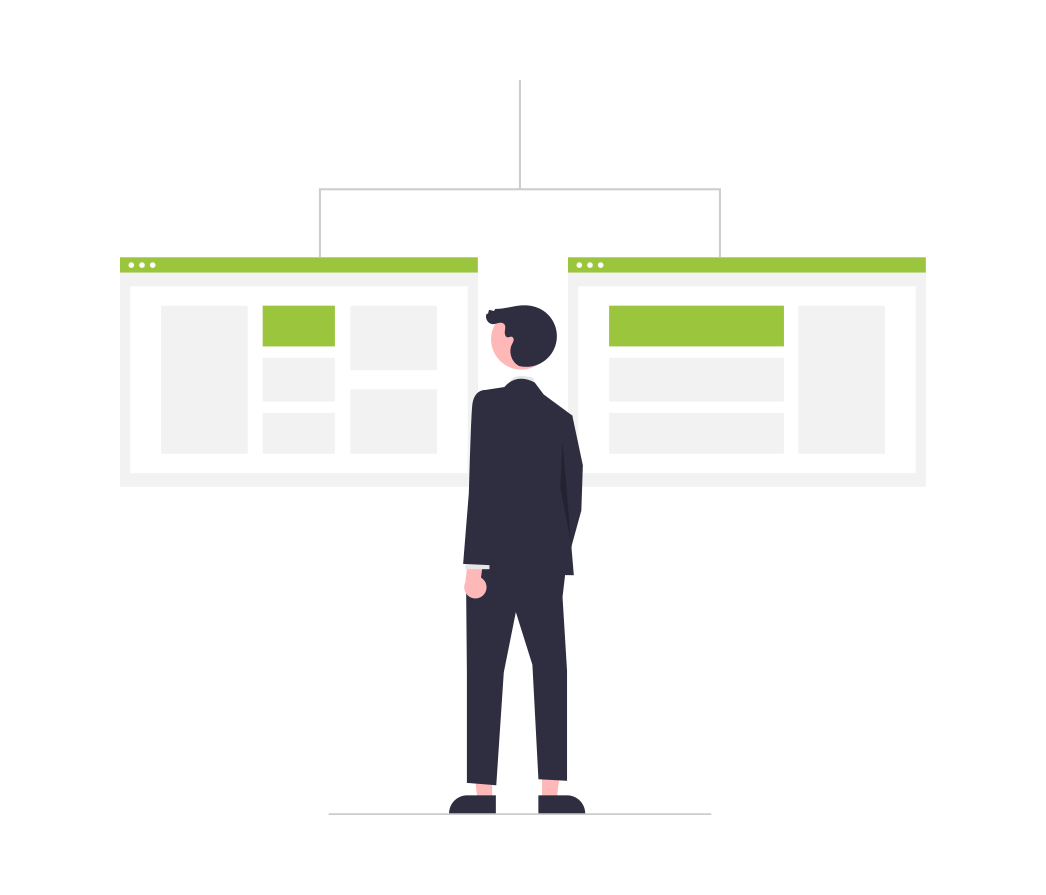
Say you'd like you'd like to test out the performance of one type of creative against another or perhaps you're able to geo-target against different DMAs because you've got a feeling that one city might perform better than the other. How do you validate your theory?
With dynamic ad insertion and SmartPromos, you're able to test performance outcomes. Just create two SmartPromo campaigns, with a unique pixel for each variable you're looking to test would lead you to a conclusion.
Now that you can A/B test your audio ads, what variables you should test?
The most common variables to test out in podcasting include:
- Messaging: Does highlighting one aspect of your show perform better than another?
- Targeting: For programmatic ad buys, what variables can you change? Do cities with higher household incomes react better to a certain type of message? What about targeting different age groups or other demographic segments?
- Length: Is 30 seconds just the right amount of time to sell your show?
- Voice: Does the way your ad is read drive different results — for example, would a female voice drive better results than a male voice?
- Ad unit: Does your show perform better with pre-rolls, mid-rolls, or episode drops?
- Calls to action: Does "subscribe" work better than "listen now"?
Like audio, A/B testing in digital media lets you test many variables. Utilizing SmartLinks, Chartable users have tested multiple elements, including:
- Creative (e.g. banners / text)
- Audience segments such as demographic, interests, and behavior
- Different platforms like Facebook, Snapchat, or TikTok
- Different ad units such as banners, text ads, videos, etc.
With SmartLinks you’re able to take tactics and strategies digital marketers have used for years and apply them towards your podcast. We’ve seen publishers use SmartLinks to A/B test different audience segments on Facebook, run display campaigns, use their SmartLink as the call to action on YouTube influencer campaigns or satellite radio—and get a ton of detail on their Cost Per Download as a result.

Growing your show doesn't require any magic—you just need to follow our four simple steps.
Just set your goals, make a media plan, measure your results, optimize and repeat. That's it.
Measurable results mean you can now create effective campaigns to grow your podcast, learn what works and what doesn't, and use that information to determine where you should invest your time and money.
At Chartable, we love hearing about the creative ways marketers grow their audience — we'd love to hear what works best for you!
More than any of our other posts, this guide is a joint effort. Chartable's COO Karo Chakhlasyan is the primary author, drawing upon his years of experience writing the chart-topping playbook at Wondery prior to joining us here. Special thanks also to Megan Johnson, Christian Buckler, and Aaron Dowd from the Chartable team for their edits.
